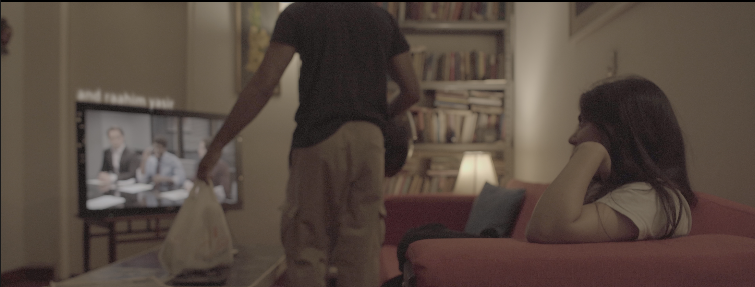Sound Design Part 1
- zainfaridr
- Apr 8
- 5 min read
Updated: May 19
From the start, I knew that sound wasn’t just something to layer on top of visuals. It was a core part of the storytelling itself. Long before I began editing, I had already recorded ambient sounds, captured the atmosphere of each location, and planned how sound would shape the emotional rhythm of the film. Every choice was intentional.
But it wasn’t until I began piecing everything together that I really saw how much weight the sound carried. The quiet moments weren’t just empty space. They became opportunities to let the audience breathe, think, and feel. Guided not by what was being said, but by what was being heard in the background or in the silence itself.
This post is a full breakdown of the sound design process. From field recordings and ambient layers to custom-built scores and sound mixing techniques, I’ve detailed every step I took to shape the sonic identity of the film. Because in this project, sound didn’t just support the visuals. It carried its own meaning. It spoke when words didn’t.
Dialogue & Voice Audio
Out of everything in post-production, cleaning dialogue was the most tedious and time consuming. I started with raw, fragmented audio takes, many glitched, noisy, or just plain incomprehensible. Getting them crisp enough to sound filmic took a layered approach and a lot of patience.
The process began with syncing. Since many audio clips were part of longer files, I first trimmed and exported each relevant dialogue section. After that, I brought them into Audacity to clean them up individually.
For every dialogue clip:
I’d find a portion with no speech — pure silence — and use that to create a noise profile, which I then applied to remove background noise. This method worked far better than letting the software “guess” what to clean.

Next came a noise gate, adjusted differently for each clip, depending on the loudness. This filtered out persistent low decibel junk: faint buzzing, electrical hums, distant hissing.

Then came Filter Curve EQ correction. I rolled off the lows for speech (dialogue doesn’t need it), then selectively boosted certain bass frequencies to reintroduce body and realism. After that, I bumped up the treble and applied a custom preset I created unique to each actor’s vocal profile. These boosts targeted specific frequencies to enhance clarity without over-processing. These act as layers that pile on one another once applied, rather than the adjustments fighting with each other, they compliment and work congruently.
This resulted in clean, clear dialogue but sometimes too clean. Some clips had reverb or echo issues baked in from location acoustics. After exporting them back into DaVinci Resolve (Studio), I applied DaVinci’s Voice Isolation FX, using it sparingly (usually between 8–15 out of 100) just to tame the reflections.

Challenges
My Zoom H6 mic was too good. It picked up stuff I couldn’t even hear in person. Things like far-off humming or sharp breaths from me standing offscreen, because apparently I breathe like a Victorian chimney.
Some actors whispered their lines while others yelled. I had to normalize volume across clips to prevent sudden jumps. The loudness normalization was adjusted manually but not just for peak values but also target loudness, for smoother listening.

Overall, it was less about making everything perfect and more about making it believable by shaping the dialogue audio so it sits in the world of the film without pulling attention to itself.
Diegetic Sounds
Every sound you hear in this film, literally every single one, was added in post. None of the production sound made it in. That meant one thing: layering. Painstaking, detail-obsessed layering.
Let’s go about this chronologically, starting at the beginning:
Living Room Scene
The TV audio playing SNL wasn’t just slapped on. I recorded it straight from YouTube, then:
EQ’d it to mimic how real TV speakers sound (which tend to kill bass and exaggerate the midrange).

Ran it through a plugin called PlaceIt, which adds spatial reverb. This made the TV feel like it was actually in the room, not just a voiceover slapped on top.

I also panned the TV audio based on camera perspective: right panned when the couch is on the left, left panned when we face the door. That subtle shift helps the audience subconsciously map out the space, creating verisimilitude.

Then came the door opening offscreen. The initial SFX felt too flat, so I added reverb and panned it right, syncing it with the next camera angle to build spatial logic.

Footsteps on Carpet
Impossible to find online: I needed footsteps that sounded heavy but muffled. Carpeted, but not weak. I tried Envato, no luck. So I built it myself.
Foley setup: used my boots, walked in place, recorded using a mic placed away from the floor to avoid vibration being captured.
Cleaned it up, then added reverb tailored to the room.
Synced each step precisely, even though the actor’s legs weren’t fully visible — because even a slight audio mismatch would break immersion.

I would show the video I made of me recording the footsteps, but I am dressed too embarrassingly to post it publicly here. So here is the next best option, a screenshot of the same setup but whilst recording a different foley sound (for a shot that got cut from the final video).

Object Interactions
This was an entire beast on its own. Because the actor was holding a bag with a bottle inside, a helmet, and other objects, and placing them around silently on set, I had to fake everything:
The bag rustling had layers: the fabric, the bottle inside, the thud against the table all compounded into one audio clip "bag rustling."
The helmet placement had to reflect the weight distribution. The first touch, the delayed full impact and be muffled just enough to reflect the padded grip.
Used ElevenLabs AI for hyper-specific SFX where Foley wasn’t worth the time, like:
“A helmet being placed gently on a fragile wooden table with tiles on top, one side touches first with 30% of the weight being placed on it…”

example
Even that needed tweaking in Resolve to match the timing and feel.
Same went for the bottle inside the bag: muffled impact, table thud, fabric tension releasing, everything was hand-layered. Some sounds were synced to invisible actions (e.g. body sways or minor shifts), just to preserve physicality.
The Cupboard Scene
When the knuckle dusters fall out, we initially don’t see the cupboard open, we just hear it. So the sound had to carry that whole moment:
Cupboard door creak
Cloth rustle as she pulls it
Objects shifting
Knuckle impact - layered with subtle metallic scrape + deep thud
Extra objects falling (to avoid making it feel too choreographed)
Cloth drop after she’s distracted by the weapon

All of this to sell the moment. Again, panning was used to position the audio behind the camera, making Saif’s turn toward the sound feel justified.
The Laptop Scene
Audio from the laptop video had to feel like it was coming from the laptop, not the audience's speaker:
Rolled off bass via EQ to match cheap speaker profile
Added room-tailored reverb via PlaceIt
Synced externally and panned slightly to show spatial positioning
The Fight Scene
This took the most work. Ten seconds of screen time = dozens of individual SFX.
Each moment had layers:
Approach: quiet, fast footsteps + heavy breathing
Kick: leg swing whoosh, impact thud, grunt from Saif, pain yelp from Ikhlaq
Wall slam: body impact, reverberation, grunt
Punches:
Each one unique. I used punch SFX with high, mid, and low frequency layers to create a thick, crunchy sound.
Some had metallic elements (knuckledusters), some bone crack layers.
Added subtle breath exhalations from Saif, synced to each punch (real fighters time their exhale with strikes).
Fall: full-body thud, groan, breathing aftermath
The aim was realism, not cartoon violence. I didn’t want a looped punch sound, every hit had its own tone, impact weight, and reaction.
I will talk about music design, mixing, and my thoughts on this process in the next post.

























Comments